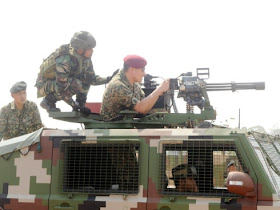On Jurong Island yesterday, Autonomous Tractor-Trailers (ATTs) were showcased to the media. The driverless prime movers are used to haul cargo around the island on flatbed trailers.
You can't tell the ATT is a smart truck as the driverless vehicles look just like any other prime mover.
The driver’s cabin on the optionally-manned ATTs grants the
operator the flexibility to adapt deployment patterns to changing traffic
conditions. This feature also adds to the resilience of the unmanned system. For example, a driver
can take over if the unmanned system is hit by a fault or should demanding traffic conditions arise that fall outside the ATT's design parameters or fuzzy logic algorithm, thus ensuring
continuity of service.
For places like Singapore that have strict rules governing what moves
on the roads and how these vehicles are controlled, the optionally-manned
feature may be the only way for unmanned systems to get the clearance required for
real-world deployments.
If land transport regulations are strict, imagine the tangle
of do’s and don’ts for air navigation.
For Singapore, the optionally-manned feature may have to be
a design requirement for unmanned aircraft systems (UAS) with an expanded performance envelope and mission capability.
In time to come, we can expect such drones to complement
piloted aircraft flown by the Republic of Singapore Air Force (RSAF). Advanced drones can be assigned for those dull, dirty or dangerous missions for which
unmanned systems excel at performing as the loss of a drone can be mitigated
by fielding a replacement. You can’t say the same for the limited number of
manned air platforms, or aircrew.
Earlier this month, Scaled Composites unveiled an intriguing experimental aircraft, the Model 401, that could conceivably morph into a UAS... someday.
Scaled Composites is an American company not unknown to
Singapore’s defence community.
We first reached out to Burt Rutan’s talented and
passionate design team more than a decade ago when Singapore defence engineers needed a
partner to design and build an optionally-manned airborne surveillance aircraft
known as the LALEE. The platform was projected as a possible replacment for the E-2C Hawkeye.
The name Low-Altitude, Long Enduring Endurance referred to
the platform’s operational height which was lower than that of surveillance
satellites – the word “low” being relative to the operational height of
satellites. Alas, the project did not take off due to export restrictions from
the United States.
But times and attitudes may have changed since then.
Scaled Composites’ Model 401, unveiled early in October'17, is worth reading about.
Future system: The Scaled Composites Model 401 is being developed for an unnamed "proprietary customer". While the prototype does not have an optionally-manned feature, a drone version could (in future) complement manned aircraft assigned for demanding missions. Photo: Scaled Composites.
Here is Scaled Composite's news release on the M401 prototype:
Mojave, California – October 11, 2017 Scaled Composites is
proud to announce the rollout and first flight of its most recent project, experimental
aircraft Model 401. Scaled worked with a proprietary customer to build two
vehicles to demonstrate advanced, low-cost manufacturing techniques and to
provide aircraft for research flight services to industry partners and the
United States government.
The two vehicles were designed to be identical in
outer mold line and performance, with each aircraft powered by a single Pratt
& Whitney JTD-15D-5D engine with 3,045 pounds of thrust.
The vehicles are capable of
flying Mach 0.6 with a service ceiling of 30,000 feet and have a wingspan of 38
feet and are 38 feet long. They have an empty weight of 4,000 pounds and a
maximum take-off weight of 8,000 pounds with an endurance of up to three hours.
Aaron Cassebeer, Project Engineer said, “This is such an exciting time for us.
Scaled is at the forefront of experimental aircraft development and I am
fortunate enough to have a front row seat.” He went on to say this about the
mission, “Today was a great day for our test team. We had a great flight and we
are looking forward to the future test program.”
This successful first flight
is the beginning of the flight test phase for vehicle number 1. The Scaled team
plans to continue envelope expansion on the first aircraft as they move toward
first flight of the second Model 401 vehicle.
Model 401 test flight video courtesy of Scaled Composites
You may also like:
Why the sale of the F-35 Joint Strike Fighter to Singapore continues to elude Lockheed Martin. Click
here
US dashes Singapore's hopes for breakthrough in comprehensive awareness. More on the LALEE project. Click
here







